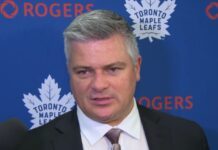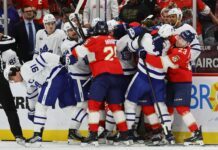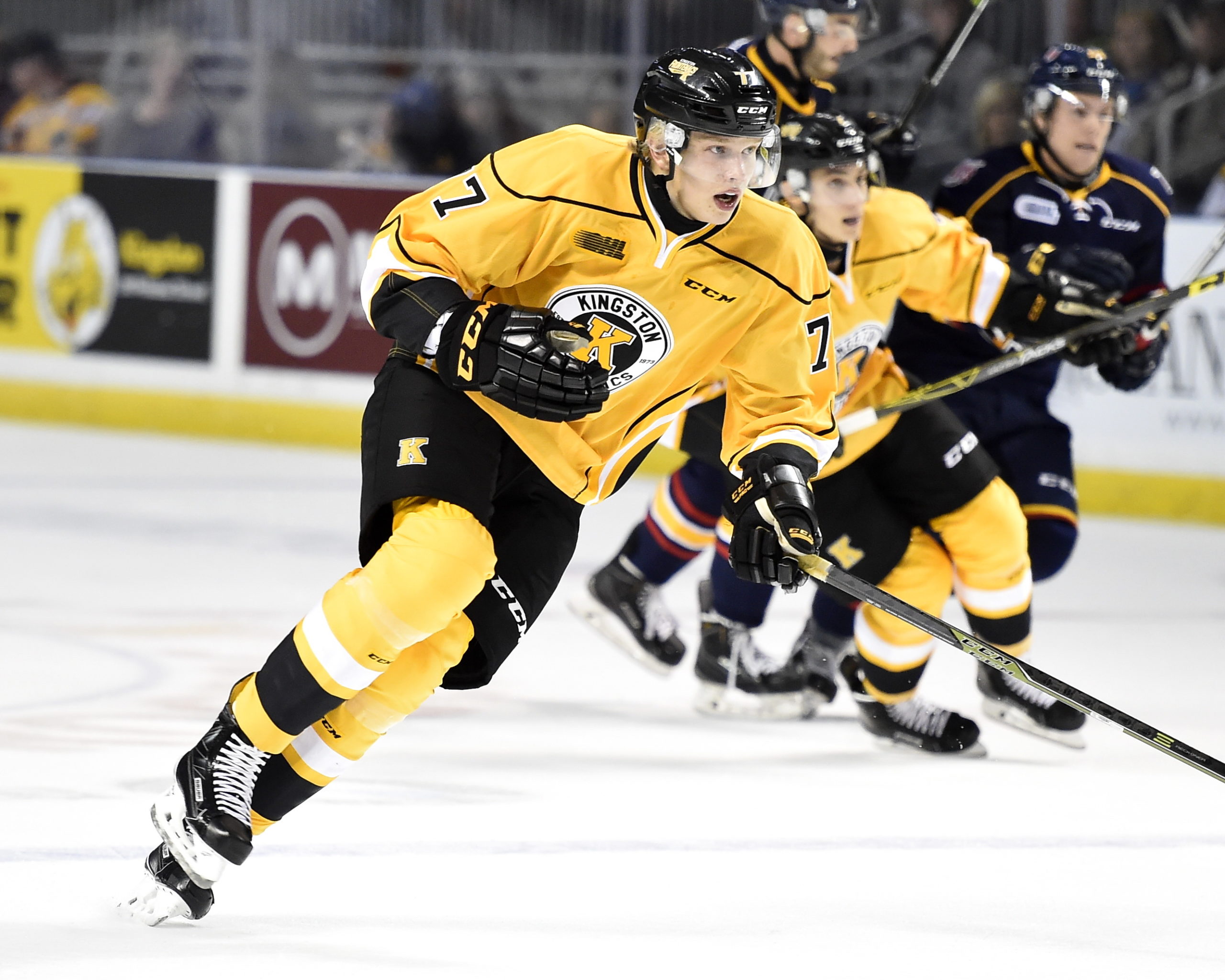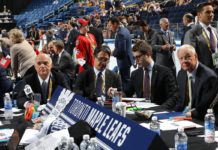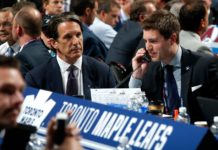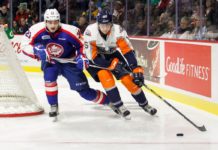Since Mark Hunter left the OHL’s London Knights to join the Toronto Maple Leafs’ front office staff in 2015, the Leafs have averaged three picks from the Ontario Hockey League per NHL draft.
This year was no different: The Leafs selected Eemeli Rasanen of Kingston in the second round, Fedor Gordeev of Flint in the fifth round, and Ryan McGregor of Sarnia in the sixth round. Let’s take a closer look at what these three players currently bring to the table and what they could potentially develop into in the future.
#59: Eemeli Rasanen / Kingston Frontenacs / Defense / 6’6, 214lbs
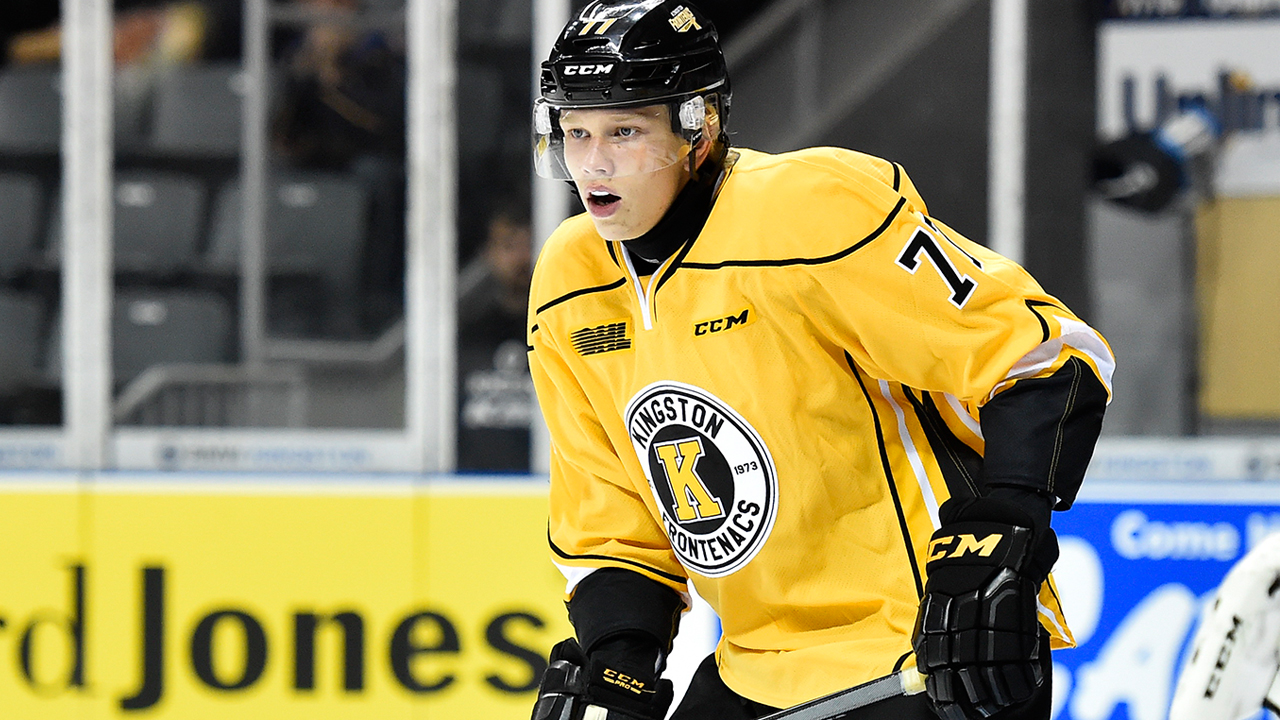
| GP | G | A | Pts | +/- | ESP | PPP |
|---|---|---|---|---|---|---|
| 66 | 6 | 33 | 39 | -7 | 9 | 30 |
When the Kingston Frontenacs drafted Rasanen in the second round of the 2016 Import Draft, not much was known about the hulking blueliner, but he made an immediate impact in the OHL this year and secured a spot in Kingston’s top four very early on. His quick transition to the league was one of the main reasons why the Frontenacs were the Eastern Conference’s top defensive team and a top four team in the Conference overall.
Rasanen is a very raw defensive prospect, and part of that can be explained by the fact that he hasn’t been playing competitive hockey for very long. Rasanen told reporters earlier this season that he had only been playing at a high level for five years or so. The projectability of his skill set is obviously one of the contributing factors that made him alluring to the Leafs at pick #59. He could only be scratching the surface of his potential.
Strengths
You can’t talk about Rasanen’s strengths without mentioning his size. That 6’6 reach (which could obviously still grow further) makes him a particularly difficult player to get around. His stick-checking ability is really effective in the defensive end. In the open ice, he’s also a very physical player who relishes the opportunity to plaster an opponent cutting to the net with his head down. As he gains strength and fills out his lanky frame, we have to imagine that this area continues to improve.
Rasanen also possesses a booming point shot which he utilizes well on the point of the powerplay. It’s both hard and accurate and gives him the potential to score way more than six goals as his junior career progresses.
He also possesses good mobility moving forward. His straight-line speed and stride is solid for a bigger defender and it allows him to flash some ability as a puck rusher.
Weaknesses
When I was doing research for the annual CHL Import Draft Review last July, I talked to McKeen’s scout Marco Bambino about Rasanen. It’s funny to look back on that now; the weaknesses Marco mentioned wound up being spot on.
Rasanen struggles with his lateral and backwards mobility and this prevents his long reach from being as effective as it should be in the defensive end. This was really evident at the World Under 18s, where Rasanen struggled a bit when defending against speed on the big ice.
He also struggles with his decision making in the defensive end. He can be very turnover prone against teams with strong forechecks. I think this is partially influenced by his choppy footwork, but there’s no question that his first pass under pressure needs to improve.
I’d also like to see Rasanen utilize his size more to his advantage in the corners and in front of the net. While he’s certainly a threat to hammer an opponent in the open ice, he needs to be more aggressive defending the crease and in loose puck battles. You don’t want to see a 6’6 defender losing battles to 5’11 forwards in the corners, and that happened way too often this season.
Projection
Rasanen will return to the OHL next year and continue to play a top-four role for the Kingston Frontenacs. The Fronts have a chance to be a top four team in the Eastern Conference yet again next season, although it will be under a new head coach after the Florida Panthers hired away the terrific Paul McFarland. Hopefully, Rasanen can improve his skating this offseason and gain more confidence in his abilities at both ends. He posted 39 points as an OHL rookie last year, so a 10+ goal, 45+ point sophomore year is not an unreasonable projection. This is especially true if Kingston can find a way to score a little more (they were the lowest scoring team in the entire OHL in 2016-17). Even then, the success of this pick cannot be measured after one season. Rasanen is a project — one that is probably at least three years away from contributing at the NHL level. Patience will be key, but the upside could make him worth the wait if he develops into a quality top-four defender.
Draft Grade: B-
This was certainly where I expected Rasanen to go in the draft, so I don’t think that the Leafs reached on him, but there would have been other players I would have had more confidence in at pick #59. Again, patience will be key.
#141: Fedor Gordeev / Flint Firebirds / Defense / 6’6, 211lbs
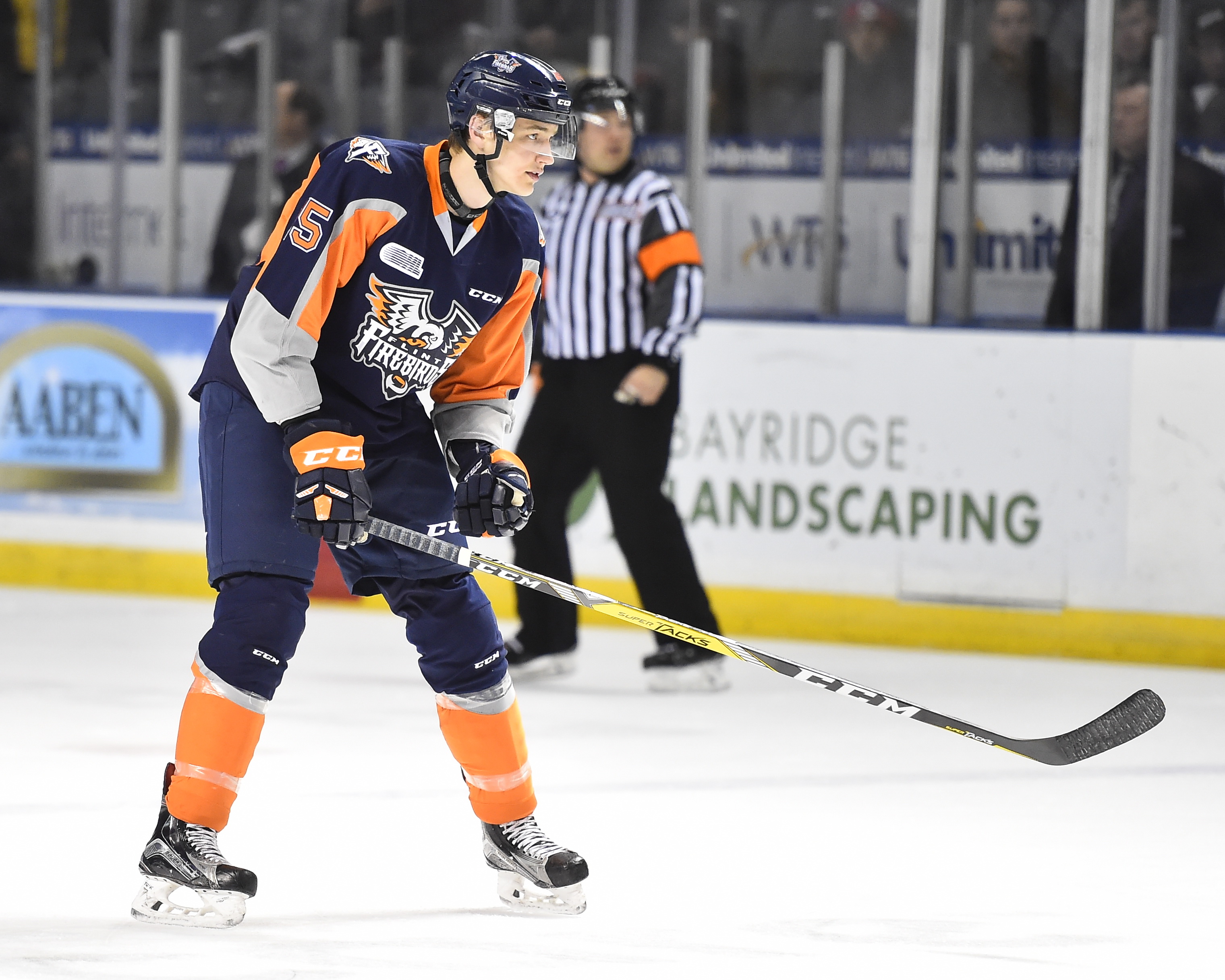
| GP | G | A | Pts | +/- | ESP | PPP |
|---|---|---|---|---|---|---|
| 64 | 4 | 10 | 14 | -3 | 12 | 2 |
Even though Gordeev was drafted 82 spots lower than Rasanen, they are actually quite similar prospects who possess similar potential. No question, Rasanen is further along in his development at this point, but that shouldn’t take away from the fact that Gordeev could be a diamond in the rough for the Maple Leafs.
Gordeev, too, was an OHL rookie this year after playing the 2015-16 campaign in Ancaster of the GOJHL. He moved to Flint early this season after being one of the main components of a deal that brought Will Bitten to Hamilton. In Flint, Gordeev initially struggled, but he improved every month to the point where he was firmly in the team’s top four by season’s end. That progression is what quietly made him one of the top risers the OHL had to offer heading into the 2017 draft.
Strengths
“We had a veteran defence. We had two overagers and a 19-year-old who signed with Arizona. Fedor was the fourth guy in our mix. Those older players have now left and he’s going to have tons more responsibility this year. The sky’s the limit for him.”
– Flint Firebirds head coach Ryan Oulahen (full interview)
Again, I think you need to start with size being a major asset here. Gordeev uses his size to be aggressive more consistently than Rasanen does. He is already a difficult player to go up against in the corners and in front of the net. He wins the majority of his battles and he really gained confidence in a shutdown role as the season wore on.
Gordeev is also a more fluid skater than Rasanen. For a 6’6 defender, I would grade him as an excellent skater. This makes him a very difficult player to get around off the rush when you combine his reach and his mobility.
As an offensive player, Gordeev is very raw. At the minor midget and Junior B levels, Gordeev put up decent offensive numbers, but that did not translate to the OHL level this season. He plays a relatively safe game with the puck, often deferring to other players. But, later in the year, we saw him begin to take more chances rushing the puck out of his own end or pinching to keep pucks alive in the offensive zone. There are OHL observers high on his offensive potential at this level.
Weaknesses
While Gordeev is a more willing physical combatant than Rasanen, his overall defensive game is more raw. His reads and decision making in the defensive end remain a work in progress and it’s something that he will need to work on in order to develop into a top-notch stay-at-home defender. However, he does possess the skill set to develop into one and already showed progression in this area later in the OHL season.
Gordeev also needs to improve his first pass and overall play with the puck. As mentioned, he can be quick to defer to his defensive partner or a backchecking forward to lug the puck out of his zone. His skating ability gives him the potential to develop as an offensive blueliner, but he needs to gain confidence in order to take chances with the puck. It remains to be seen whether he can make significant strides in this area of his game.
That decision-making with the puck will also need to improve if he ever intends to be a powerplay QB at the OHL level (and beyond). Gordeev will also need to improve his shot, especially his ability to fit it through traffic. He’s a big kid, so sheer physics suggests that he should be able to develop it into a weapon.
Projection
The Flint Firebirds, after a few years of turmoil, have really turned things around under one of the best young coaches in the CHL (Ryan Oulahen). This is a young team that could be one of the OHL’s best by Gordeev’s final season in the league. In 2017-18, Gordeev will be a second-year player and should continue to blossom. He’ll have a chance to regain a top-four role, but he’ll have some talented youngsters nipping at his heels. If the progression he showed at the end of the year is legitimate, he could have a very solid year. I wouldn’t worry so much about his offensive production; if he can be a 25+ point player next season, that would be terrific so long as his defensive game continues to improve.
Draft Grade: B
The Leafs have taken a few of these types of players (all from the OHL) in recent drafts: Keaton Middleton, Nic Mattinen, and now Rasanen and Gordeev. You have to think that one of these defencemen can develop into a quality, punishing defender for the parent club. Of the four, Gordeev is actually the best skater, in my opinion, and that’s what makes this selection a good one, especially when combined with the improvement he’s already shown. I actually expected an NHL team to take a chance on Gordeev earlier than the fifth round.
#172: Ryan McGregor / Winger / Sarnia Sting / 5’11, 177lbs
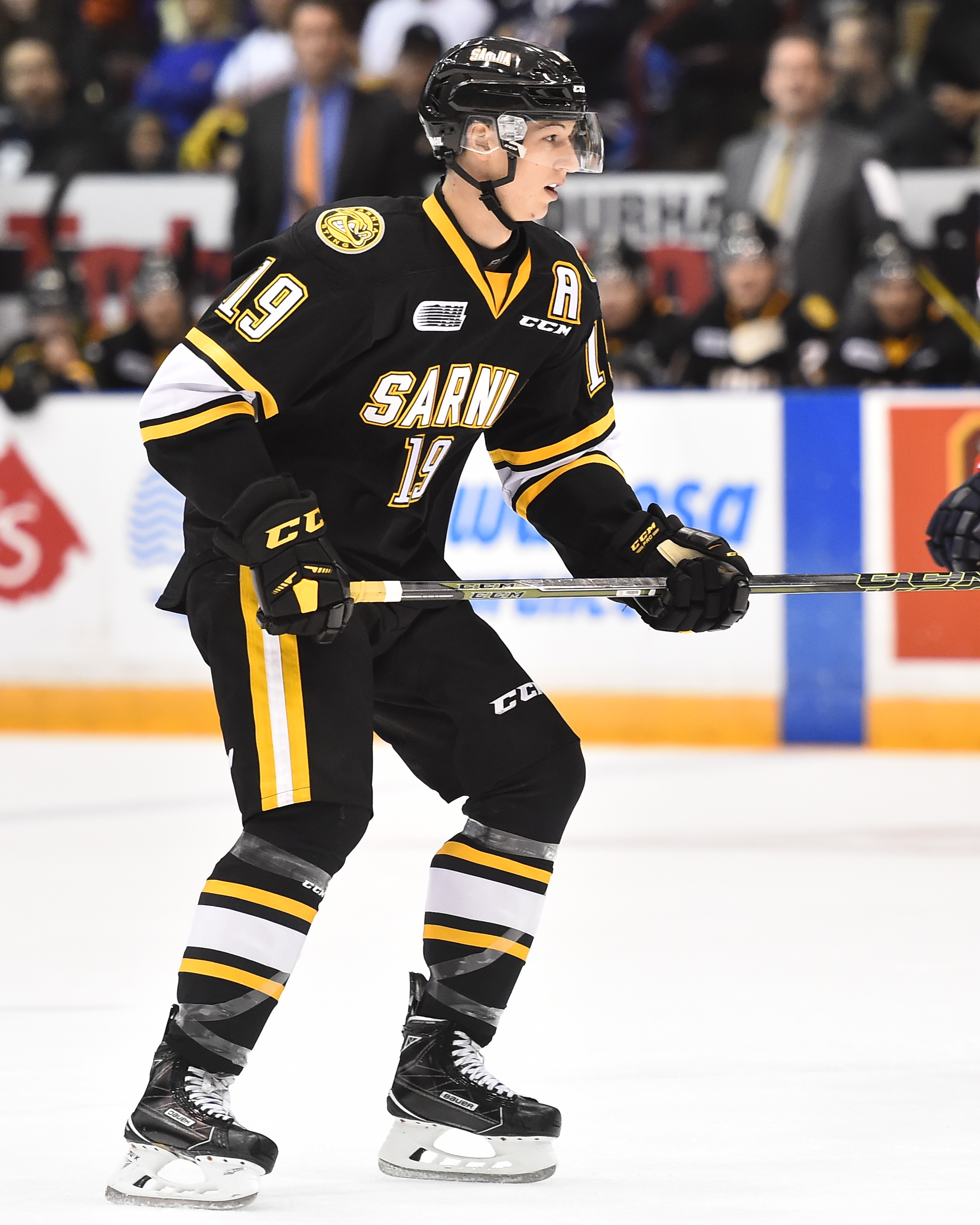
| GP | G | A | Pts | +/- | ESP | PPP |
|---|---|---|---|---|---|---|
| 65 | 14 | 13 | 27 | -1 | 24 | 3 |
Entering the year and even early on in the regular season, it was looking like McGregor could be a candidate for the first three rounds by June. He put together an excellent rookie year with Sarnia last year as a 16/17-year-old, and he started strong in 2016-17. But the second half was not kind to him, with only one goal in the final 27 games of the regular season. With a lack of size, the lack of production is bound to correlate with a drop in the draft. But that does not necessarily mean McGregor was a poor selection, nor does it mean that he can’t rebound next year.
Strengths
The first thing you notice when you watch McGregor is his speed. His first few steps are very quick and his top speed is one of the best on his team in Sarnia. He explodes down the wing and is a major factor in creating scoring chances off the rush.
McGregor also possesses good hands and puck skills that would suggest he has goal-scoring potential moving forward. He also has a good wrist shot that he can utilize at top speed coming down the wing.
While the effectiveness of his ability as a two-way player is inconsistent because of a lack of strength, he does possess good two-way sense. His speed can be a major asset on the penalty kill and he does a good job of getting his stick in passing lanes on the backcheck and as part of the PK. His motor is always running.
Weaknesses
As alluded to, strength is a major issue for McGregor. He’s too easily pushed off of the puck. As such, he’s not able to utilize his speed as well as he should be able to. This also prevents him from being a factor in close to the net. At times, it can give off the impression that he’s a perimeter player.
Ditto for his inability to win battles in the corners consistently. His speed could be a major asset on the forecheck, but he can’t seem to maintain possession long enough to create offensive chances out of turnovers.
As of right now, he’s really only a factor off the rush offensively. Once the game slows down, he’s just not nearly as noticeable. He certainly works hard though, and – again — I think this is tied to a lack of strength and conditioning.
To a certain degree, I wonder about his potential as a goal scorer, too. How well does he think the game in the offensive end? Any player who goes as long as he does without scoring a goal, despite possessing some weapons, is open to that criticism. Does he top out as simply a hard-working penalty killer who brings energy but not much else?
Projection
Sarnia will be returning pretty much all of their main offensive weapons next year (save for overager Jaden Lindo), which means that McGregor will be fighting for ice time as a top-six winger. With a strong offseason spent improving his conditioning, McGregor has a chance to play second fiddle to a player like Jordan Kyrou or Adam Ruzicka, where he’ll get his share of scoring chances. I could easily see him doubling his goal scoring totals next year. I could also see him only increasing his production modestly before a larger breakout as a 20-year-old two years from now. Either way, McGregor’s speed makes him a player worth monitoring as he tries to round out the rest of his game.
Draft Grade: B-
When you’re drafting in the sixth round, it’s pretty hard to make a definitively poor selection. While there were other players I would have preferred at that spot (similar to Rasanen), you couldn’t call McGregor’s selection a poor one. Because of his speed, he has projection as an NHL player, even if his game is relatively raw. The Ottawa Senators used a second rounder on Alex Formenton, a player whose profile is similar, even if he’s most definitely a better prospect at this stage in time. Speed and heart are worth gambling on. This is especially true when you consider the fact that McGregor started the year so positively before he hit a physical wall.





